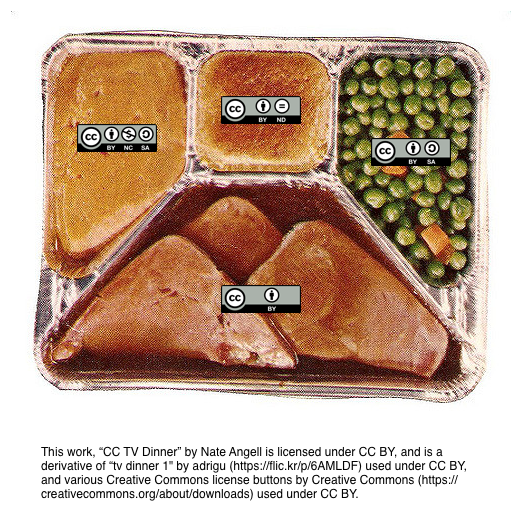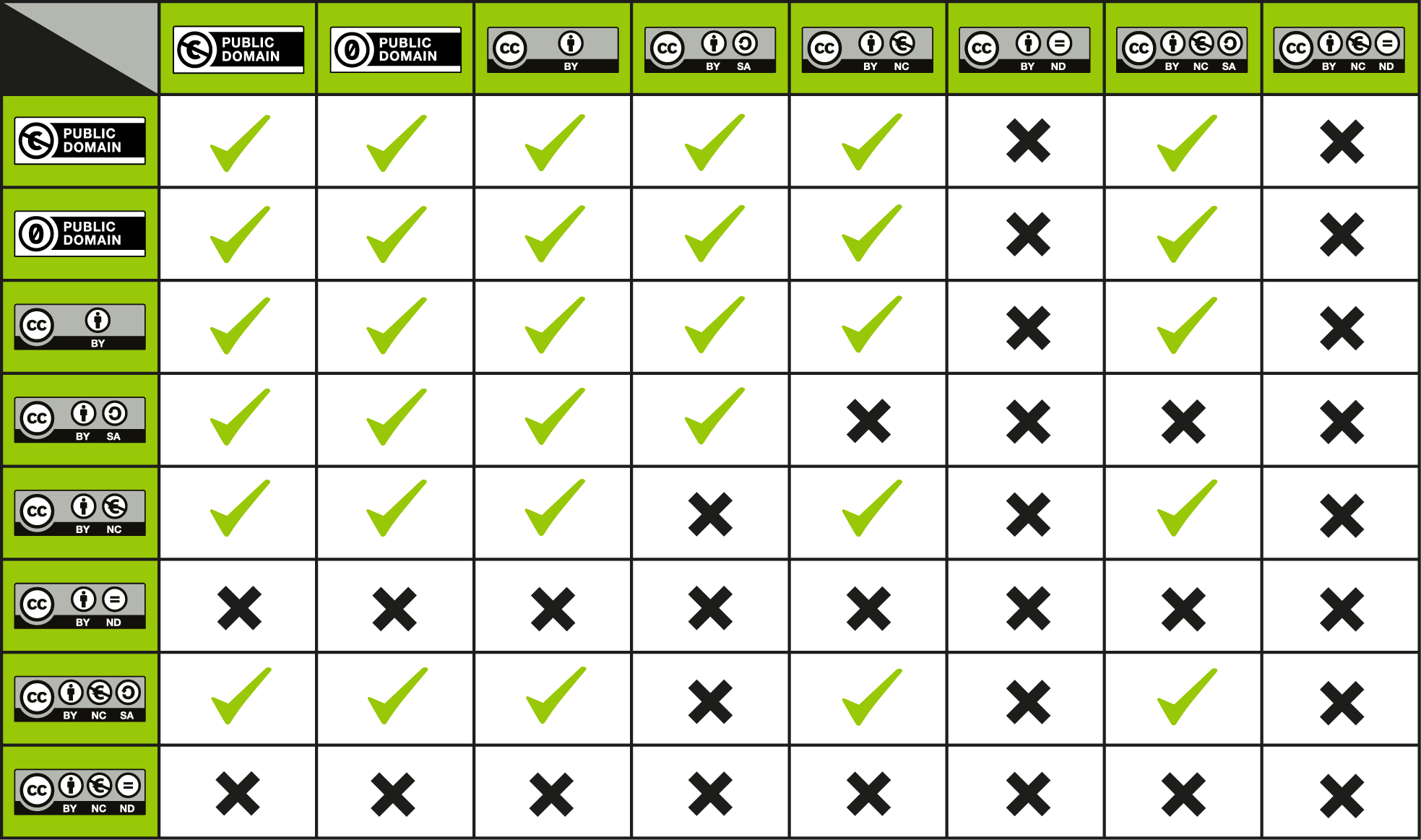


Sharing a CC licensed work on it's own is relatively simple. You can easily share it with others by making copies (in any format) as long as you abide by the license agreement. However, by only sharing, you are limiting yourself from the vast possibilities open to you by the CC licensing system. CC opens the door for you to make your mark on the CC licensed works you use. By using a CC licensed textbook in your class you have the ability to take chapters from a variety of CC licensed works to create a collection that could be used as your own textbook. You can also take a CC licensed textbook (or other work) and re-write parts of the book you find out-of-date or do not fit with the material in your course. This page will explain the differences between collections and adaptations to help you feel more comfortable in using CC licensed works to your fullest ability.
 You create a collection when you put together a group of works with clear boundaries on the individual works. Creating an anthology of works would be considered a collection for CC purposes. In the end, it should be easy for the user to determine where each part came from and the parts themselves should not intermingle with one another. A commonly used metaphor for this was created by Nate Angell where he equates a collection with a TV Dinner. Each individual food in a TV dinner is in their own compartment and can be consumed by themselves without intermingling.
You create a collection when you put together a group of works with clear boundaries on the individual works. Creating an anthology of works would be considered a collection for CC purposes. In the end, it should be easy for the user to determine where each part came from and the parts themselves should not intermingle with one another. A commonly used metaphor for this was created by Nate Angell where he equates a collection with a TV Dinner. Each individual food in a TV dinner is in their own compartment and can be consumed by themselves without intermingling.
“CC TV Dinner” by Nate Angell is licensed under CC BY, and is a derivative of “tv dinner 1″ by adrigu (https://flic.kr/p/6AMLDF) used under CC BY, and various Creative Commons license buttons by Creative Commons (https://creativecommons.org/about/downloads) used under CC BY.
When you create a collection, each work should include it's original attribution statement and as you did not make any changes to the individual pieces you do not create a CC license stating that made any changes. You should, however, create a CC license for your contributions such as the arrangement of the works, any cover art, and/or an introduction. You could also include questions after each work as a guide for reading that you can license.
One area of confusion with collections are works that include the NoDerivatives license term. Creative Commons has clarified that using a ND work within a collection does not create a derivative work. This also covers the ShareAlike license term as well, since the ShareAlike license also applies to adapted works. On the other hand, the NoCommercial term could be a consideration of the individual pieces if you are using your collection for monetary gain. Fortunately this would not prevent a college bookstore from printing copies of your collection and selling them to students to cover the cost of the printing.

This is an example of a collection. Each work is displayed on it's own with clear boundaries between the different works. As the creator of this collection, I am able to add a CC license on to the arrangement of the work but not the images themselves. It is important that I include all of the attribution statements so others can find these works to use themselves and simply to recognized who owns each individual part.

"OER images" by Kelly Kornkven is licensed under a Creative Commons Attribution-ShareAlike 4.0 International License. It is a collection of the following works, listed clockwise from the upper-left corner:
"Open access overview: Focusing on open access to peer-reviewed research articles and their preprints" by opensourceway is licensed under CC BY-SA 2.0
"Flat World Knowledge: Open College Textbooks" by opensourceway is licensed under CC BY-SA 2.0
"Open Education" by Chris P Jobling is licensed under CC BY-NC 2.0
"Do you speak my language? Education versus open source processes and principles" by opensourceway is licensed under CC BY-SA 2.0
 Another way to use CC licensed works is to create adaptions. When you create an adaptation, you take works and remix them and derive a new work. For example, if you take a chapter from a CC licensed textbook and add or remove information from it, you would be creating and adaptation. Another example would be taking a CC licensed picture and using a photo editor to make an internet meme by adding text. As with collections, Nate Angell has a metaphor to assist where he explains that an adaptation is like a smoothie. After you have blended the ingredients together, it is difficult to separate the works.
Another way to use CC licensed works is to create adaptions. When you create an adaptation, you take works and remix them and derive a new work. For example, if you take a chapter from a CC licensed textbook and add or remove information from it, you would be creating and adaptation. Another example would be taking a CC licensed picture and using a photo editor to make an internet meme by adding text. As with collections, Nate Angell has a metaphor to assist where he explains that an adaptation is like a smoothie. After you have blended the ingredients together, it is difficult to separate the works.
For CC licenses, it is not considered a derivative work if you only change the format or if you are editing a work to remove misspellings. This definition of an adaptation differs for U.S. Copyright law where an adaptation/derived work is created when you change the format of a work such as digitizing a old newspaper article.
“CC Smoothie” by Nate Angell. CC BY. Derivative of “Strawberry Smoothie On Glass Jar” by Element5 (https://www.pexels.com/photo/strawberry-smoothie-on-glass-jar-775032/) in the public domain, and various Creative Commons license buttons by Creative Commons (https://creativecommons.org/about/downloads) used under CC BY.

Not all CC licenses allow you to share adaptations of works. If the material you would like to derive a work from has a license with the NoDerivatives term, you can create an adaptation but you will not be able to share it publicly. Another consideration is if the work has the ShareAlike clause which means that if you do decide to share your adaptation you will need to due so with the same CC license or a compatible license as the original work. If you plan to use your adaptation for profit, you will want to ensure non of the works you are using have the NonCommercial term.
This chart can help you determine which licenses are compatible with one another as you determine a license for your derived work.
"Using CC Licensed Works" is a derivative of the September 2020 Creative Commons Certificate Course by Creative Commons, licensed CC BY 4.0. Kelly Kornkven adapted content from the Creative Commons Certificate Course Unit 4 on the Remixing CC-Licensed Work, by summarizing main points and adding additional CC licensed graphics.
